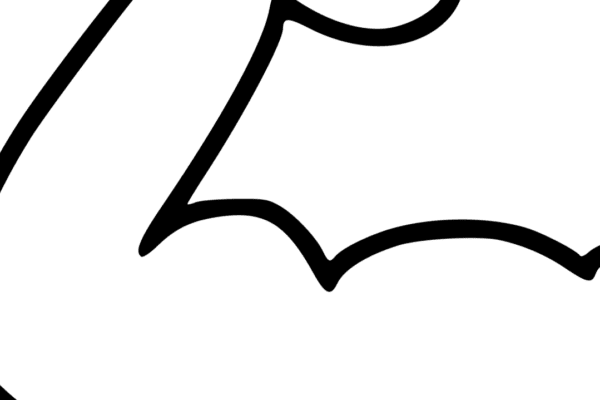Reflect To Improve
We all need time to reflect on our actions and experiences in order to understand them better. This is especially true for leaders who are responsible for the team. However, how many of us truly take the time to properly revisit and examine the different events of the day? Many of us simply skip over the day and move on to the next. This is a mistake for many reasons, which we will explain later in the article. Reflective cycles make a big difference in our understanding of our actions and what we can learn moving forward.
Today, we’re addressing some of the different reflective cycles that are available. We look at each selected model, discuss its advantages and disadvantages, as well as help you select the model that suits you best. Each model brings its own set of steps that allow us to use them easily and effectively. So it’s up to you to decide which model best meets your needs and the needs of your team.
Some articles will look at 3 models of reflection. And others look at 5 reflection models. Instead, we look at 8 different models and cycles that can work for you.
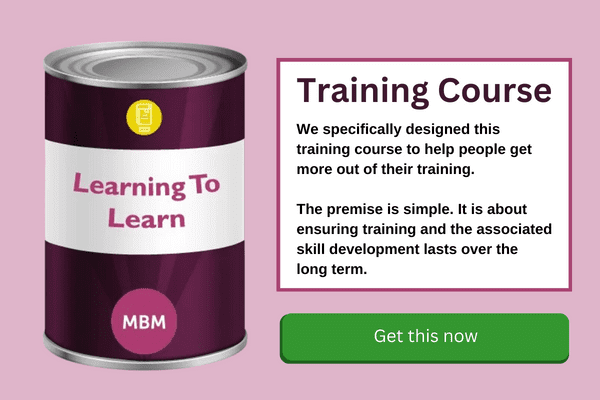
What Are Reflective Cycles?
Reflective practices are all about reviewing your experiences and actions to learn from them and improve. In other words, we learn from what we have been through. We select best practices as well as areas of improvement. This is about reviewing both small and larger events and learning from everything we go through. Every experience has something we can develop from. The improvements may be individual or team steps that need to be taken.
Reflective cycles are models that allow us to complete this process. We have structure and steps to follow with each of the available models or cycles. Note that the main difference between the different types is the number of steps. Some of the shorter models still contain the actions necessary, just in a more condensed form. Regardless, they all bring benefits that allow your reflections to help you grow, develop and improve.
8 Effective Reflective Cycles
Here, we look at 8 different reflective cycles that make a difference. These models have their similarities, as you will see. However, each has its own benefits that we will explore. So let’s get started.
1. Kolb’s Reflective Cycle
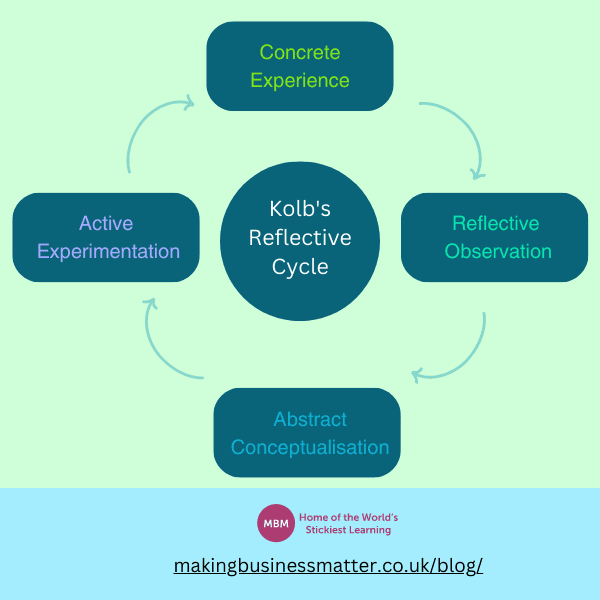
Our first reflective cycle was coined by David Kolb in 1984 in his learning and reflective model. There are 4 steps to follow in this example.
- Concrete experience
- Reflective observation
- Abstract conceptualisation
- Active experimentation
This model is based on personal experiences and learning from them. We identify, analyse and evaluate. Let’s look at each of the 4 steps to better understand their meaning and use. This cycle allows for ongoing continuous learning and improvement by following the different steps.
Sticky Learning ® is 7 times more effective than 1-day training courses. Plus, you will get a Chain of Evidence proving your Return on Investment. Discover soft skills training that changes behaviours long term.

Concrete Experience
Here, you identify the event you experienced. You break it down step-by-step. This first step allows you to break down the event into smaller stages that are easier to analyse. Some questions you can use in this step are:
- What happened? (general overview)
- During the experience, what did I do? (your specific role and actions)
- What did others do? (how others reacted and behaved)
By asking these questions, you look at the experience as a whole from different view points. You can look at words as well as actions, emotions and interactions.
Reflective Observation
Next, we analyse the answers to the questions in the first step. Here, we look in more detail at the events of the experience. Once you have the overview, you need to look at different aspects of the reflection. You look at:
- What went well?
- Is there anything that could have been better?
- Why did the situation happen that way?
- Was it because of my actions or the actions of others?
All of these questions will give your reflective step more focus to move to the next step.
Abstract Conceptualisation
Here, we move on from the previous steps with potentials and hypotheticals that can lead to identifying areas of improvement. For example, ask:
- If I faced this situation again, what would I do differently?
- How could I improve moving forward in a similar situation?
- Where can I guide others to do better in the future?
These types of questions allow for action steps to be identified. In this way, we know what to do differently moving forward, learning from personal experience.
Active Experimentation
Now, we know what to do differently. Therefore, it’s time for action. We use this final step to put our plans into action, making improvements on past experiences that we identified in earlier steps of the reflective cycle. Here, new steps and strategies are used to make positive differences from the reflections. And, this step leads right around to the initial step we first looked at as needed.
This model gives us all the chance to learn from what we personally go through. It guides us through the experience, reflection of the event, possible alternatives and future action to take. Overall, it’s quite simple in its 4-step approach.
Related: Read more on Kolb’s reflective cycle.
2. Gibbs Reflective Cycle

Next, we look at the 6-step model from Graham Gibbs. Yet another 80’s model, this 1988 further develops on Kolb’s model by breaking the process into 6 stages for more detailed evaluation. The process has the following steps:
- Description
- Feelings
- Evaluation
- Analysis
- Conclusion
- Action Plan
As you can see, some of the steps are similar to the previous example. However, we see one specific difference which gets it’s own step, which is feelings. Let’s see how the model works in practice.
Description
Like with Kolb’s model, this reflective cycle begins with an overview of the event or experience that occurred. Also, like Kolb, the experience is very often a personal or individual experience. However, it can be used for team or group experiences as well. You ask similar questions as before. You can break it down into the following sections:
- What happened?
- Why did it happen that way?
- Who was involved?
- What was my particular role?
Here, we see multiple aspects of the overall experience and clarify specific details at this stage.
Feelings
Now, we look at something different. Here, we specifically reflect on how the experience made us feel. This is an important step. We are all human, with emotions. However, these emotions can hinder our experiences if not properly managed. By having this step to identify our emotional responses and feelings, we better understand how this impacted the overall experience. Sample questions at this stage include:
- What did I feel during that experience?
- Why did I feel that way?
- How do my feelings impact my behaviour?
- What impact do those feelings have on those involved?
- Were my emotions under control throughout the experience?
- Did I allow my emotions to overtake the experience at any stage?
All managers need to have self-awareness of their feelings and emotions during different situations. Our emotional responses can negatively impact experiences we are involved in as well as those we are interacting with. This is an important clarification which is useful in this particular reflective cycle.
Evaluation
Now, we evaluate the answers to all of the questions from the previous 2 steps. Again, like other models, we ask questions here that get to the details of what went well and what could be improved. No model is complete without this important review. Remember, these reflective models are guiding us to improvements and growth. We all learn from experience through proper evaluation and reflection.
Analysis
Our next step is very much the “why” stage of the process. Here, we look at why the experience went well or didn’t. It is important that you are honest with your self-analysis of where improvements are needed. Without that honest approach, the next steps will not make the difference that is necessary to properly develop.
Conclusion
Now, bring all of your findings together to understand the action steps that are required. Ideally, you know by now what needs to be improved moving forward. If you are still unclear, revisit the previous steps to create clarity. This conclusion allows you to do the final review of your findings.
Action Plan
Finally, we put our findings into practical steps. Ideas are great. However, actions make change happen. Therefore, create a structured action plan. Set clear goals and objectives to work towards. Then, ensure you use steps that are realistic and will allow for improvements to occur. Also, review your action plan regularly to check your progress and review changes that have happened.
I have personally used this reflective cycle in my leadership roles. I find the structure effective and easy to use. Some might find the 6-step model overwhelming at first. However, stick with it, you will see the positive changes once you get into the swing of using this model.
Related: Read more on Gibb’s Reflective Cycle and watch our video which explains with an example.
3. ERA Reflective Cycle
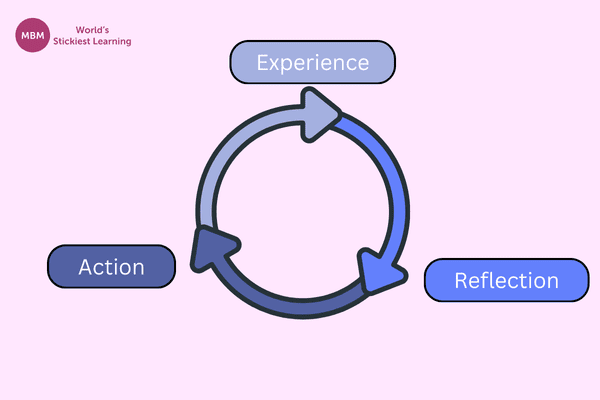
Now, let’s look at this 3-step model. In 2013, Melanie Jasper introduced us to the ERA reflective cycle in her book “Beginning of Reflective Model”. This really is the simplest of the models involving the following steps:
- Experience
- Reflection
- Action
It really couldn’t be much simpler.
Experience
Here, we have a detailed overview of all aspects of the experience. We look at:
- What happened?
- Why did it happen that way?
- How did the experience make you and others feel?
- What about the experience was new or different?
- How does this experience compare to others?
You need to delve deep into all aspects of the experience to properly analyse each area. Don’t leave anything out.
Reflection
So, the obvious next step is to reflect and review what you discovered in the first step. Here, as before, we look at the aspects that went well and those that we will work on to improve. Ask those familiar questions:
- What worked well?
- Where can improvements be made?
- How did I and others act in this situation?
- What, if anything, did we learn from the experience?
- Who acted well during the experience and who needs training or enhancement of their skills?
You get the idea of the type of questions we are asking at this point. The main aim is to properly identify the strengths and areas of improvement using this stage of the reflective cycle.
Action
Here, the 3rd and final step is taking action. As I stated before, ideas are great. However, it’s only through action that we really make a change for the better. In this way, approach this step with proper structure and SMART objectives. Avoid making your action points too vague. You need proper focus to move forward.
I probably should have started with this one, seeing as it’s the shortest. However, I found that the steps for this model were quite vague. For me, it didn’t give the same level of structure that I like using. Alternatively, I know from speaking to others about their experiences, that many people prefer the simpler approach and find it very effective and user-friendly. Remember, different tools work differently for each of us.
4. Driscoll’s Model of Reflection

Now, let’s have a look at the next reflective cycle. Here, we have the Model of Reflection by John Driscoll from 1994 and is another 3-step framework. The steps are focused around the 3 WHATs that we look at in this example.
- What?
- So what?
- Now what?
Here, the wording is very different from the other models we have seen until now. So let’s make sure we understand each step properly.
What
Here, we start by doing a “what” question list of the experience or situation. So, start each question with WHAT; what was the situation? Also, what were the reactions of others? Next, what were your roles and responsibilities in the experience? Then, what was the outcome? All of these questions and others will help you identify what actually happened in the situation. To properly understand this, follow the “What” structure to find the details of the entire event. Again, don’t leave anything out, especially the negative aspects of the experience.
So What
Next, look at evaluating the impact this had on everyone involved and the experience as a whole. Again, use the stage name “So What” as your lead for all of your questions, like above. For example, so what— :
- Were the feelings of everyone involved?
- Would you list as the positives of the situation?
- Are the negatives that came as a result of the experience?
- Would you do differently in the same situation in the future?
- Have you learned from the whole experience?
All of these “So What” questions highlight the need for change and improvement moving forward.
Now What
Finally, we need to move forward with what we have discovered. Therefore, use “Now What” options to look at action steps to improve. This can include identification of training needs, necessary coaching, role-playing to build confidence, etc. There are many options available in this step of the process. Structure the plan and share it with those involved. Be sure to set time frames and place measures to check progress. Also, recognise and reward success as a result of the contribution and effort from everyone.
This stage leads to skill enhancement and growth. We learn from every experience if we are ready to analyse it properly and accept that changes are needed.
Use the wording of each stage to guide you in your questions. Therefore, you understand what you are looking for in each area of reflection.
5. 4 Fs of Active Reviewing
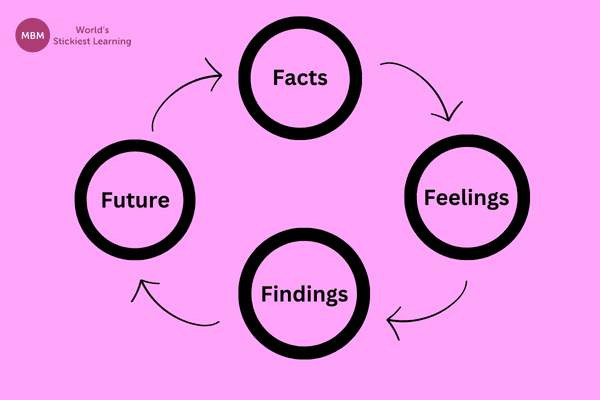
Now, we move to to Dr. Roger Greenaway’s 4 Fs framework. As an expert in the education sector, he developed this model to help people critically analyse situations, their outcomes and further action. I like this framework for it’s simplicity of terms and, therefore, ease of use. Also, it’s another reflective cycle that includes a specific area for feelings.
Here, we see the 4 Fs of:
- Facts
- Feelings
- Findings
- Future
Actually, it’s very easy to remember and quite catchy. The 4-step structure of the model is effective and avoids overwhelming the user. Although Dr. Greenaway was from the educational sector, this framework translates effectively to any industry.
Facts
As usual, we start by reviewing the details of the experience. Remember, include all of the details, don’t leave anything out.
- Look at the Who, What, Why, When, Where and How of the whole event.
- Break the details into easy-to-use sections that you can work with later.
- Include expected outcomes and real events.
- Highlight the highs and lows of the experience.
Here, we stick to the facts of the situation. Avoid elaborating or exaggerating details. That will not help with our analysis later in the model.
Feelings
Now, we focus on the emotional aspect of the event. This can be achieved with effective Emotional Intelligence skills. Focus on the feelings involved in the event; yours, your team, your customer, etc.
These include feelings of inclusion/exclusion, emotional signs in people’s voice and body language, and emotional language used during the encounter. All of these aspects impact any experience.
Findings
Now, look at the findings of the above mentioned sections of the model. This analysis highlights where change is needed. These reflections create the roadmap for what is to come in the final stage of the framework.
The findings will include:
- What worked and what didn’t.
- How to do it differently with more positive results.
- Who needs training or development.
Now, these findings will guide you in the final stage of this model.
Future
Finally, create a plan moving forward. Look to the future and improvements that are needed. Also, focus on how to really make a lasting difference that will ensure experiences in the future are positive and productive for everyone involved.
6. The CARL Framework of Reflection

Now, our next reflective cycle is the CARL Framework of Reflection. This is a very effective tool to use for interviewing and performance review situations. The sections of the model make for great structured questioning for proper reflection of situations and experiences. The model contains:
- Context
- Action
- Results
- Learnings
I have personally used this structure for interviews and performance review meetings and can highly recommend it. So, let’s look at the breakdown of the 4-step model.
Context
Here, we set the scene for the entire event or experience. We create a clear understanding for the listener of exactly what was happening during that time. We look at:
- What was happening
- Who was involved
- What the expected outcome was
- How the situation occurred in the first place
The scene is set for you to then take the next step of analysing the actions.
Action
Now, we look at what we did and how we might have acted differently. We ask a number of why questions in this section of the process. Some examples include:
- Why did we react/act that way?
- Why did others react/act the way that they did?
- Would we do anything differently in the future?
- What impact did our actions have on the situation and others?
- Why was this action not effective?
There is good room for analysis here for you to move to the next section.
Results
So, we now look at the outcome of the whole experience. We ask ourselves questions about the final part of the event. This will let us know where we stand and where to go next.
- How did you end the experience?
- Were you successful in achieving your results?
- If not, what can you improve on moving forward?
- What next steps do you need to take to resolve the situation effectively?
Here, we put our action plan together and start making the necessary changes you identified in the earlier steps of the cycle.
Learnings
Finally, we reflect on what we have learned from the whole experience. I really like this section. It makes you stop and think about what the real takeaways from the whole experience are. You ask the following questions:
- First, what did I learn from the experience?
- Next, what will I do differently in the same situation in the future?
- Also, how can I share the learning with my team?
- Finally, how can I measure improvements moving forward?
This reflective model works well because you are dealing with real-life situations rather than hypotheticals. This is a great way to learn from your reflections.
7. Atkins and Murphy’s Model of Reflection

Here, we have a 5-step model for the next reflective cycle. We saw this framework appear in 1994 from Atkins and Murphy. So, let’s look at this approach.
- Awareness
- Describe
- Analyse
- Evaluate
- Identify
Again, the model is similar to others that are available. Actually, the main differences are terminology and the number of steps to follow. One big difference for me is the very first step in this model; awareness.
Awareness
So, this first step differs from other reflective cycles because Atkins and Murphy included the step to create awareness of what our triggers are and how that can impact different experiences and situations we deal with. Ideally, every cycle should have this step identified in their model. However, we only really see this cycle give that important step its own focus. Actually, more models need to include this, in my opinion.
At this stage, self-awareness is essential. As a key element of Emotional Intelligence, those of us who are more self-aware will perform better in this first step. First, be honest about your emotional and behavioural responses and reactions in situations.
Next, ask the tough questions that only you have the answers to. For example, what were you feeling and thinking right before this situation? So, could this have effected the way you handled the situation? Or, what triggers can you identify before or during the event that changed your handling of the situation? Then, take a step back and look at the emotions and reactions of others involved. Remember, social awareness is important too.
Describe
Now, we move on to the overview of the experience. We ask questions in this section that give us a big-picture view. Again, we ask the What, Where, When, Why, Who and How questions, similar to other models. The details are critically identified and everything is included, no matter how big or small. Only with this deep dive into the details will you be able to better complete the following steps in the model.
Analyse
Now, we properly analyse all of our findings from the previous 2 steps. We ask those familiar questions, such as:
- What main factors contributed to the experience?
- How would you describe your contribution to the situation?
- What impact did others make on the experience?
Obviously, add additional questions that help you properly analyse the entire event.
Evaluate
Now, you need to look at what worked and what needs to be changed. However, make sure you have covered the previous stages properly. Otherwise, your findings will have gaps. Use questions such as:
- What was the final outcome?
- How does this outcome benefit everyone involved?
- What would you change about managing this situation again in the future?
- How can you make the necessary changes for improvement?
It will then lead you to your action plan steps in the final stage of the model.
Identify
So, we are on the 5th and final step. Here, ensure you have gathered all of the necessary information to determine your next moves. Also, determine whether these steps are required for you, or others, or everyone involved. Then, focus on what you have learned from the entire experience and the use of the reflection cycle. Finally, take action. Plans only make positive changes with action.
Related: Read more about Atkins and Murphy Model of Reflection.
8. Schon’s Reflective Model

Finally, we have our 8th reflection cycle, Schon’s Model. Here, we see Donald Schon’s model from 1991, with 3 steps to follow. Again, this framework has some similarities. However, there are some notable differences with this final selection. So, let’s take a look.
An important difference with this model is the stage of reflection DURING the event. Yes, it makes you start your reflection while still fully involved in the experience. As a former operations manager in hospitality, I can completely relate to how this reflection works. Basically, it’s about using on-the-spot reflections to adjust your actions and behaviours in the course of managing the situation you are involved in. I know, from personal experience, that many leaders need to know how to put this into practice.
This reflective cycle consists of the following steps:
- Knowledge in Action
- Reflection in Action
- Reflection on Action
Knowledge In Action
First, we create an understanding of what we already know about the current situation. Imagine, a colleague comes to your office asking for help with a particular task. Thankfully, it’s a task you are familiar with.
Therefore, at this stage, you are prepared to offer assistance and guidance. Or, you are faced with a customer complaint that is similar to one you have handled in the past. This experience will give you the knowledge required to take necessary action.
So, we start this model checking our level of knowledge and understanding of the situation at hand. Also, we reflect on how that knowledge will help us cope with this particular event.
Reflection In Action
Now, we change things up a bit. Here, we start our reflections DURING the experience as it happens. As mentioned, this differs from other models, which highlight the reflections happening AFTER the experience is over. Therefore, ask some of the following questions:
- What is happening right now?
- How does this situation make me feel?
- Are there changes in my actions or behaviour that can help manage the situation better?
- How are others coping with the situation?
- Are there other factors that I need to consider now to get the right outcome?
Here, we are thinking about the here and now. Therefore, the questions need to be all about the present and what can be changed to make the situation better. The main idea of this stage is to make the necessary changes and corrections at the time of the situation to improve the chances of getting the right outcome for everyone involved.
From experience, I can confirm that this stage is SO important. It’s great to take steps after different events to improve moving forward. However, reflecting during the situation keeps you present in the present, allowing you to make better decisions and act more effectively.
Reflection On Action
Now, we move to the reflection AFTER the experience. Like all other models, we review the situation after the fact and identify the learning points from the experience. Then, we create our action plan and steps for improvement moving forward.
It is important to note that there are many models available out there. What’s important to understand is WHY we should know and use them.
Importance of Reflection
So, we have looked at 8 great reflective cycles with some similarities and some differences. However, what we haven’t covered yet is WHY these models are important to know and use. Let’s have a look. Reflective cycles work to:
- Create a structure for your review of your actions and experiences.
- Identify improvement steps for better results.
- Allow for growth and development.
- Acknowledge gaps in actions and behaviour when handling different situations.
- Develop effective action plans for improvement.
- Cover all aspects of a situation for analysis and change.
- Guide you through the reflection process in an efficient way.
Barriers to Using Reflective Cycles
As we can see, there are many reasons reflective cycles are important to use. However, some people struggle to utilise these useful tools for some of the following reasons.
First, some people fail to be honest about gaps or mistakes that occurred during different experiences. Here, they brush over the negative. Instead, they focus more on the positive. Or, they focus on the actions or behaviour of others, rather than themselves.
Next, some don’t see the time for reflection as a good investment. Very often, we see people simply moving on from experiences without proper reflection and consideration of what happened and what needs improvement. Here, the chance to learn and grow disappears.
Also, we might choose the wrong model for the situation we are faced with. It is important to know a variety of models and use the right one for the experience you are reflecting on. This way, you have a much better chance of seeing the positive change as a result of using the reflective cycle you choose.
Then, some leaders believe they can do no wrong. Therefore, reflective cycles are a waste of time for them. They simply don’t see the benefits of using such a useful tool. Instead, mistakes continue to be repeated and situations are mishandled due to the lack of change.
Finally, our approach to changes for team members needs to be handled correctly. This is not always the case with all leaders. Some simply don’t have the leadership skills to complete this task effectively. Instead, they make the situation worse by mishandling the reflection activity with others.
Moving Forward
So, there you have it. Eight great reflective cycles that can really make a positive difference. Just remember:
- Select the model that suits you and your style best.
- All models come with advantages and limitations.
- Try different models for different situations to see which works best.
- Be ready to move between the different approaches to get the results you need.
- Be honest in your review of the situation, especially your role, actions, and behaviour.
Be sure to look at more articles and resources available on our website that can help you to continue to grow and develop your leadership skills and lead your team effectively.


